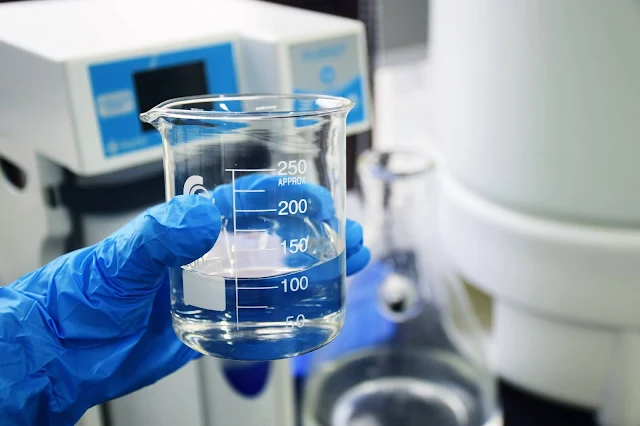The simplest method for detecting chlorides use silver nitrate which reacts with the chlorides to form cloudy white precipitates.
Materials
- Distilled or deionized water.
- Test tube, rinsed in distilled water.
- Dilute (5 % ) nitric acid, in a dropper bottle.
- Silver nitrate test solutions, in a dark bottle.
- Black or dark background with a strong sides light.
To Make Test Solution
Dissolve 1.7 grams (g) of silver nitrate crystals into 98 milliliters (ml) of distilled water. Store the solution in a dark reagents bottle in a dim or dark place, because it is somewhat light sensitive.
Procedure
1. Place a sample of the alkaline bathwater (10 to 30 ml) in the clean test tubes.
2. Add one to two drops of dilute nitric acid. Shake to mix. If the solution fizzes, continue to add acid until the fizz stops.
3. Hold the tested tube up to a strong side light with a dark area behind the test tube. Add two drops of test solution. Observe the sample closely.
4. The formation of a white precipitate indicates the presence of chlorides. If the cloudiness is so weak as to raise doubts as to its presence, compare it with an untested sample of the rinse water.
5. Thoroughly rinses the test tube with distilled or deionized water to prepare for the next sample.
To Test for Chlorides in Objects Not Yet in the Treatment
1. Prepared the object by cleaning off as much-adhering soil and losing encrustation as practical (e.g., wash, brush, chip).
2. Place the object in just enough distilled water to barely cover it.
3. Let the object soak for 1.0 days. This will allow time for the chlorides to diffuse into the water. If the contamination is very great, a detectable amount of chlorides can diffuse in minutes.
4. Take a sample of the rinse water, 10.0 to 30.0 ml, in a clean test tube. If the water is too rusty and cloudy, filter it through clean filter papers.
Interpreting Test Results
1. If the chloride concentration is below 100 parts per million (ppm), the degree of cloudiness is roughly in proportion to the chloride level. Above 100 ppm, all the reactions look equally cloudy. Thus, 250 ppm looks as cloudy as 2500 ppm.
2. With careful technique (clean test tubes, good sidelight, accurately prepared silver nitrate test solution), a concentration as low as 1.0 ppm may be detected.
3. There will likely be some detectable chlorides in the chemicals used up to make alkaline-soaking solutions, so test the solutions before the objects are immersed, as well as after soaking. The raw water used to make up the solutions should also be tested to provide a baseline.
4. To provide points of comparison, make up a sample solution with known concentrations of chlorides. Obtain one volumetric flask of 1.0-liter capacity, and a second of 100 ml capacity; four storage bottles, one liter each, of polyethylene or glass; a few grams of reagent grade sodium chloride; distilled or deionized water for rinsing and cleaning.
b. Fill a clean 1.0-liter volumetric flask almost to the mark with distilled water. In to this, dissolve 1.648 grams of reagent-grade sodium chloride. Add more water until the markup is reached. This will be a 1000 ppm solution.
c. To make a 100 ppm solution fill a clean 100 ml volumetric flask with a 1000 ppm solution. Pour this into the clean 1.0-liter volumetric flask. Fill to the mark with distilled water. This will dilute the 1000 ppm solution to 100 ppm.
d. To make a 10 ppm solution, diluted the 100 ppm solution as above.
e. To make a 1 ppm solution, diluted the 10 ppm solution as above.
f. Always rinse the flasks thoroughly in distilled water to avoid contamination of the successive solution.
5. To use the comparison solutions, pour a 10 - 30 ml quantity of each known concentration as prepared above (1 ppm/ 10 ppm/ 100 ppm/ and 1000 ppm) into separate test tubes, at the same time as a rinse solution of unknown concentration is being tested.
A visual comparison of the densities of the white precipitates in each solution should give a rough idea of between which two values the unknown solution appears from fall.
SO3 Content of TRO | Determine sulfur trioxide
Procedure
Take about 4.0 grams sample of TR Oil and dilute it to 500 ml.
Take 10 ml of this solution in a 100 ml measuring cylinder. Add 25 ml methylene blue solution. Add 15 ml chloroform and shake well. Then titrate against Hyenine solution.
Calculation sulphur trioxide = Reading * 1.6 / accurate weight of sample taken.


